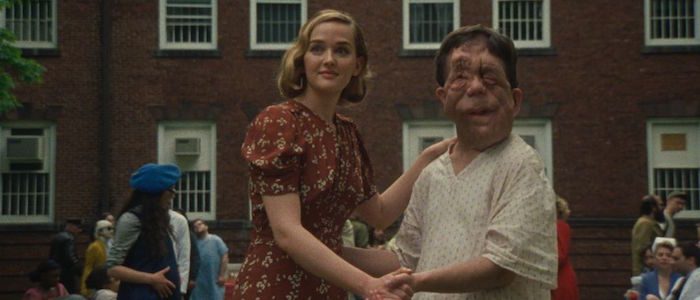‘Chained for Life’ is a Masterful Dissection of How the Film Industry Treats Disability [Fantasia Film Festival]

“Blindness is an illness, but it’s also a metaphor,” explains the actress Mabel (Jess Weixler) in an interview with a skeptical journalist. She’s talking about her role as a blind woman in a sordid arthouse horror film set in a hospital for the disfigured and genetically abnormal. As she, a sight-seeing woman, defends her choice to play a blind woman amid much controversy, she squirms a little. She knows she’s bullshitting. How do you play a metaphor when you have no experience of that which is symbolized? Do we impose metaphors on that which makes us uncomfortable, functioning as a coping mechanism?
These are the questions Chained for Life tackles directly..
Hollywood doesn’t have a great track record when it comes to representing disability and disfigurement. That’s a given. It’s long been fascinated with the spectacle of deformity, and marvels at those beautiful women that fall in love with “monsters,” despite (or because of?) their disfigurement. From Freaks to The Elephant Man to The Theory of Everything, cinema usually alternates between pity porn and demonization. Chained for Life is in direct dialogue with those films, criticizing them while posing a whole new set of questions.
Masterfully directed by Aaron Shimberg, Chained for Life (which borrows its title from the 1952 exploitation film about conjoined twins) is a wonderfully funny and empathetic meta-commentary, a behind-the-scenes drama in the style of Cassavetes’ Opening Night and Truffaut’s La Nuit Americaine. The film being made within the film is a campy horror flick, the first English production from a Herzog-like German director (played by child actor Charlie Korsmo). Mabel plays the beautiful lead, with a laughable German accent. She is blind, but when her surgeon (Stephen Plunkett) restores her sight, she is horrified to discover that her lover (Adam Pearson of Under the Skin fame) is terribly disfigured. Her repulsion is her downfall, as gets face-full of acid thrown at her.
We don’t see much of this film being shot. Shimberg trusts that we are already too familiar with the film’s modus operandi. He is more interested in the discussions that happen off-screen; how pretentious directors justify their bad choices to their actors and how able-bodied actors interact with their disabled co-stars.
There are many scenes that begin with the audience thinking we are watching reality, but with the yell of “Cut!”, it is unveiled as being a part of one of the films/realities that make up Chained for Life (yes, there are many). But these reveals don’t feel like ‘gotcha!’ moments. They simultaneously raise our suspicions for future scenes and encourage us to retroactively question which cinematic tropes seep into our everyday interactions.
The film takes it a step further when the disabled actors and extras, forced to sleep over at the hospital, make use of the equipment they’re supposed to be guarding and make their own film. Max, a creep and a narcissist surgeon, recycles the same quote by Joan Didion over and over again (though he doesn’t credit her): “We tell ourselves stories in order to live.” These actors are telling their own stories. And they’re not what you’d necessarily expect. Some are violent and punitive, while others are fantasy fulfillment, like the scene in which Rosenthal re-introduces himself to Mabel as a new man, with a new beautiful face. If you are given so few opportunities to tell “your” story, do you tell the one the paying-public will want to see?
Shimberg treats his characters with such tenderness. Mabel and Rosenthal are co-leads in both films. They’re not so much an odd couple as an awkward couple. But this awkwardness is entirely on Mabel’s end, as she tries to get to know him and see beyond his disfigurement. By the end, their friendship seems as natural and complex as any. Rosenthal is allowed to be a character that is not defined by his disfigurement, and yet was cast in the horror film because of it. In one scene in which Mabel gives Rosenthal acting tips, Shimberg suggests that Rosenthal’s inability to display affect via facial expression is perhaps what’s most unsettling to outsiders. What is he thinking and feeling? That’s why he wrote him lines.
The film is neither a diatribe against the treatment of disabled people, nor is it an “inner beauty is what counts and besides I don’t see disability” vomit-inducing indulgence. It’s a subcutaneous exploration of film history’s fascination with disability.
The film opens with a long and lavish quote from film critic Pauline Kael about why we love to look at beautiful actors and actresses on-screen: “Actors and actresses who are beautiful start with an enormous advantage because we love to look at them.” So, if blindness is a metaphor, what about beauty?
/Film Rating: 10 out of 10
The post ‘Chained for Life’ is a Masterful Dissection of How the Film Industry Treats Disability [Fantasia Film Festival] appeared first on /Film.
from /Film https://ift.tt/2v265lS
Comments
Post a Comment